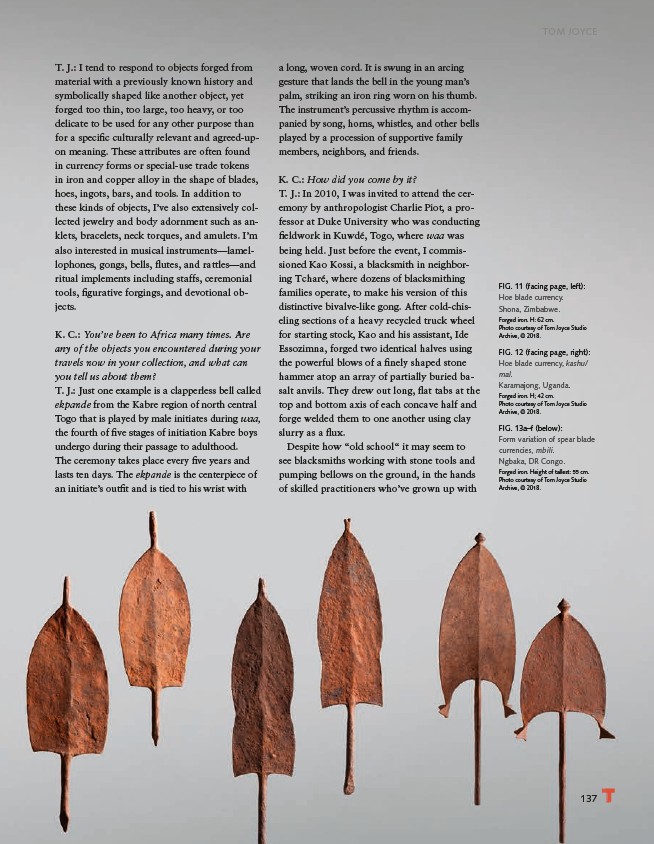
TOM JOYCE
137
T. J.: I tend to respond to objects forged from
material with a previously known history and
symbolically shaped like another object, yet
forged too thin, too large, too heavy, or too
delicate to be used for any other purpose than
for a specific culturally relevant and agreed-upon
meaning. These attributes are often found
in currency forms or special-use trade tokens
in iron and copper alloy in the shape of blades,
hoes, ingots, bars, and tools. In addition to
these kinds of objects, I’ve also extensively collected
jewelry and body adornment such as anklets,
bracelets, neck torques, and amulets. I’m
also interested in musical instruments—lamellophones,
gongs, bells, flutes, and rattles—and
ritual implements including staffs, ceremonial
tools, figurative forgings, and devotional objects.
K. C.: You’ve been to Africa many times. Are
any of the objects you encountered during your
travels now in your collection, and what can
you tell us about them?
T. J.: Just one example is a clapperless bell called
ekpande from the Kabre region of north central
Togo that is played by male initiates during waa,
the fourth of five stages of initiation Kabre boys
undergo during their passage to adulthood.
The ceremony takes place every five years and
lasts ten days. The ekpande is the centerpiece of
an initiate’s outfit and is tied to his wrist with
a long, woven cord. It is swung in an arcing
gesture that lands the bell in the young man’s
palm, striking an iron ring worn on his thumb.
The instrument’s percussive rhythm is accompanied
by song, horns, whistles, and other bells
played by a procession of supportive family
members, neighbors, and friends.
K. C.: How did you come by it?
T. J.: In 2010, I was invited to attend the ceremony
by anthropologist Charlie Piot, a professor
at Duke University who was conducting
fieldwork in Kuwdé, Togo, where waa was
being held. Just before the event, I commissioned
Kao Kossi, a blacksmith in neighboring
Tcharé, where dozens of blacksmithing
families operate, to make his version of this
distinctive bivalve-like gong. After cold-chiseling
sections of a heavy recycled truck wheel
for starting stock, Kao and his assistant, Ide
Essozimna, forged two identical halves using
the powerful blows of a finely shaped stone
hammer atop an array of partially buried basalt
anvils. They drew out long, flat tabs at the
top and bottom axis of each concave half and
forge welded them to one another using clay
slurry as a flux.
Despite how “old school“ it may seem to
see blacksmiths working with stone tools and
pumping bellows on the ground, in the hands
of skilled practitioners who’ve grown up with
FIG. 11 (facing page, left):
Hoe blade currency.
Shona, Zimbabwe.
Forged iron. H: 62 cm.
Photo courtesy of Tom Joyce Studio
Archive, © 2018.
FIG. 12 (facing page, right):
Hoe blade currency, kashu/
mal.
Karamajong, Uganda.
Forged iron. H; 42 cm.
Photo courtesy of Tom Joyce Studio
Archive, © 2018.
FIG. 13a–f (below):
Form variation of spear blade
currencies, mbili.
Ngbaka, DR Congo.
Forged iron. Height of tallest: 55 cm.
Photo courtesy of Tom Joyce Studio
Archive, © 2018.